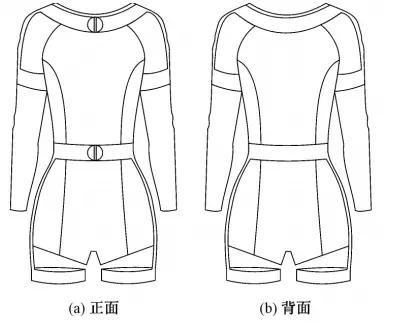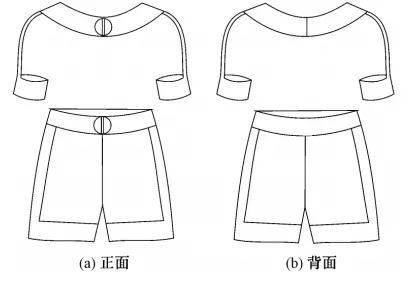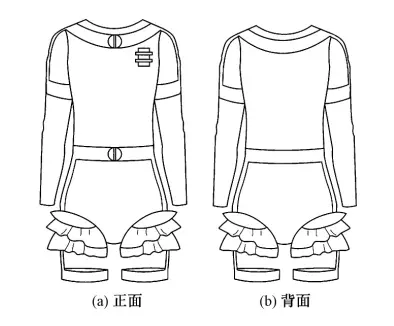Designing Floating Self-rescue Swimsuits
1.1 Structural design
Swimming is a whole-body sport. In order to reduce the increase in the quantity of water entering the swimsuit and hinder swimming, the shape of the human body must be fully considered and a well fitted segmented structure is adopted to achieve the best effect of the swimsuit being well fitted and satisfy the swimmer's comfort and unrestricted needs. According to different genders and ages, swimsuits for adult males, adult females and children swimsuits will be designed.

Figure 3 Styles of women’s swimsuits
( a) Front ( b) Back
1.1.1 Functional design of adult women’s swimsuits
The adult women's swimsuit is designed with a large round neck, knife-back splitting, and raglan sleeves with an upper and lower one-piece body-fitting structure, which can achieve a visually slimming aesthetic. Fluorescent paint is added to the side panels, and Velcro adhesive inflatable devices are used on the collar, waist, and arm circles of the swimsuit body. The style is shown in Figure 3.
1.1.2 Styles and functions of adult men’s swimming pants
Adult men's swimming pants are split lengthwise on the sides, with fluorescent paint added to the side, as shown in Figure 4.

Figure 4 Men’s swimming trunks
1.1.3 Styles and functions of Children’s swimsuits
The overall structure of children's swimsuits is the same as that of adult men's swimming trunks and women's swimsuits, but the sizes are different; because the curves of children's body shapes do not change much, there is no segmented structure, and decorative edges are added to the edges of the pants to improve childlike beauty and safety, as shown in figure 5.
1.2 Colors
The color of the swimsuit is different from the environmental color and is easy to identify, which will also increase the rescue rate. In order to achieve safety, the color of swimsuits should be blue and green such as swimming pools, oceans, lakes, ponds, etc. Swimsuits with good contrast and bright colors can easily lead to intrusion and bites by aquatic organisms, so red and yellow should be avoided for they are high-saturation colors; in addition, white and light-colored fabrics are too transparent after being soaked in water, and the visual shielding effect is poor, making it difficult to choose the color of swimsuits. Avoid the above-mentioned colors, and choose dark colors such as black, dark purple, and dark brown as the first choice for colors of swimsuits.

(a) Front (b) Back
Figure 5 Children's swimsuits
1. 3 Luminous parts
At night when visibility is low, luminescence can better play the role of warning. The luminous coating can store the light energy absorbed during the day in the fabric and continue to illuminate in the dark for more than 10 hours with good brightness. The light source is non-toxic, harmless and non-radiative. In order to increase safety at night and speed up rescue, luminous paint is added to the side of the swimsuit; in the event of an accident, rescuers can rescue according to the luminous positioning in time, saving rescue time and manpower, material and financial resources.
1. 4 Designing fabric
Swimsuit fabrics should be waterproof, breathable, and light to prevent the fabric from being heavy due to moisture absorption. Breathability provides a comfortable environment for the body; light and thin fabrics can better perform sports functions. Nylon or spandex is used for swimsuits. Spandex has superior elasticity, comfort and flatness, which can be close to the skin without any sense of oppression, and has excellent acid and alkali resistance, wear resistance, and aging resistance; its hygroscopicity is poor, which prevents the fabric from being damaged due to increased moisture absorption and hindering swimming movement. Nylon is a lightweight fabric with a lower cost than spandex. It has excellent wear resistance, durability, elasticity and elastic recovery.
1. 5 Others
When designing children's swimsuits, a GPS tracker can be installed near the collar and connected to the guardian's mobile phone. High-precision positioning facilitates rescue when swimmers are in danger; the signal and performance of the GPS tracker are susceptible to water, so it should be water resistant.
Swimming is a whole-body sport. In order to reduce the increase in the quantity of water entering the swimsuit and hinder swimming, the shape of the human body must be fully considered and a well fitted segmented structure is adopted to achieve the best effect of the swimsuit being well fitted and satisfy the swimmer's comfort and unrestricted needs. According to different genders and ages, swimsuits for adult males, adult females and children swimsuits will be designed.

Figure 3 Styles of women’s swimsuits
( a) Front ( b) Back
1.1.1 Functional design of adult women’s swimsuits
The adult women's swimsuit is designed with a large round neck, knife-back splitting, and raglan sleeves with an upper and lower one-piece body-fitting structure, which can achieve a visually slimming aesthetic. Fluorescent paint is added to the side panels, and Velcro adhesive inflatable devices are used on the collar, waist, and arm circles of the swimsuit body. The style is shown in Figure 3.
1.1.2 Styles and functions of adult men’s swimming pants
Adult men's swimming pants are split lengthwise on the sides, with fluorescent paint added to the side, as shown in Figure 4.

Figure 4 Men’s swimming trunks
1.1.3 Styles and functions of Children’s swimsuits
The overall structure of children's swimsuits is the same as that of adult men's swimming trunks and women's swimsuits, but the sizes are different; because the curves of children's body shapes do not change much, there is no segmented structure, and decorative edges are added to the edges of the pants to improve childlike beauty and safety, as shown in figure 5.
1.2 Colors
The color of the swimsuit is different from the environmental color and is easy to identify, which will also increase the rescue rate. In order to achieve safety, the color of swimsuits should be blue and green such as swimming pools, oceans, lakes, ponds, etc. Swimsuits with good contrast and bright colors can easily lead to intrusion and bites by aquatic organisms, so red and yellow should be avoided for they are high-saturation colors; in addition, white and light-colored fabrics are too transparent after being soaked in water, and the visual shielding effect is poor, making it difficult to choose the color of swimsuits. Avoid the above-mentioned colors, and choose dark colors such as black, dark purple, and dark brown as the first choice for colors of swimsuits.

(a) Front (b) Back
Figure 5 Children's swimsuits
1. 3 Luminous parts
At night when visibility is low, luminescence can better play the role of warning. The luminous coating can store the light energy absorbed during the day in the fabric and continue to illuminate in the dark for more than 10 hours with good brightness. The light source is non-toxic, harmless and non-radiative. In order to increase safety at night and speed up rescue, luminous paint is added to the side of the swimsuit; in the event of an accident, rescuers can rescue according to the luminous positioning in time, saving rescue time and manpower, material and financial resources.
1. 4 Designing fabric
Swimsuit fabrics should be waterproof, breathable, and light to prevent the fabric from being heavy due to moisture absorption. Breathability provides a comfortable environment for the body; light and thin fabrics can better perform sports functions. Nylon or spandex is used for swimsuits. Spandex has superior elasticity, comfort and flatness, which can be close to the skin without any sense of oppression, and has excellent acid and alkali resistance, wear resistance, and aging resistance; its hygroscopicity is poor, which prevents the fabric from being damaged due to increased moisture absorption and hindering swimming movement. Nylon is a lightweight fabric with a lower cost than spandex. It has excellent wear resistance, durability, elasticity and elastic recovery.
1. 5 Others
When designing children's swimsuits, a GPS tracker can be installed near the collar and connected to the guardian's mobile phone. High-precision positioning facilitates rescue when swimmers are in danger; the signal and performance of the GPS tracker are susceptible to water, so it should be water resistant.